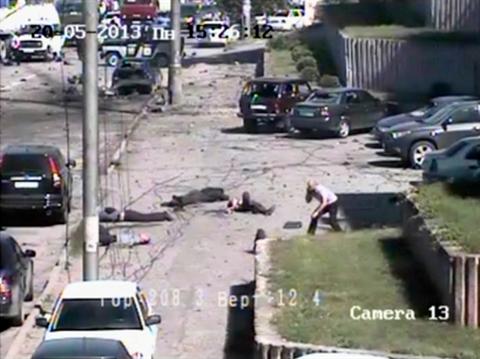
North Caucasus Prosecutor’s Office Reports Rise in Extremism-Related Crimes
Publication: Eurasia Daily Monitor Volume: 10 Issue: 217
By:

North Caucasus Federal District Deputy Prosecutor General Andrei Medvedev, recently reported that the number of extremism-related crimes in the North Caucasus rose by 40 percent in the first three quarters of 2013 in comparison to the same period of 2012. According to the official, 69 extremist crimes were registered in the district during this period. The number of such crimes increased in Karachaevo-Cherkessia from zero in 2012 to nine in 2013. At the same time, Medvedev noted terrorist attacks decreased by 10 percent, down to 399. Over 100 servicemen died and more than 300 were wounded in attacks in the first nine months of 2013, while over 200 militants were killed and more than 250 arrested (https://ria.ru/crime/20131128/980428708.html). Notably, the official did not mention civilian deaths.
Medvedev noted that Dagestan remained the center of “extremist activities,” while Ingushetia, Chechnya and Kabardino-Balkaria were the territories where the threat of terrorism remained high. Thus, the list of the most volatile regions in the North Caucasus has remained unchanged (https://kavpolit.com/goryachaya-tochka-severnogo-kavkaza/). At the same time, he pointed out that ethnic tensions in the region were on the rise. “Unemployment and the absence of stable sources of income for a significant portion of the population result in citizens’ involvement in bandit groups of extremist origin and also create a breeding ground for attempts to use ethnic tensions to fuel ethnic strife,” the deputy prosecutor general said (https://ria.ru/incidents/20131128/980416131.html#ixzz2mAsabx1a).
According to the Kavkazsky Uzel website, only 87 servicemen died in attacks in the North Caucasus in the first three quarters of 2013, not over 100, as the prosecutor stated. Kavkazsky Uzel reported that 68 civilians and 220 rebels were killed in attacks in the North Caucasus during the same period (https://www.kavkaz-uzel.ru). Such discrepancies in figures for the number of insurgents, civilians and servicemen killed are fairly widespread, which is an indicator of an ongoing information war. The Russian government normally plays down government casualties and pumps up the number of rebel casualties. What is more, various Russian government agencies have different political agendas and thus present different numbers.
During a Russian Security Council meeting held last May in the city of Pyatigorsk in Stavropol region, Moscow’s envoy to the North Caucasus, Alexander Khloponin, triumphantly reported that extremism-related crimes in the North Caucasus had hit an all-time low, decreasing by 43 percent in comparison to the previous year. At the same event, Security Council Secretary Nikolai Patrushev stated that the region was free of open inter-ethnic conflicts, “unlike [during the] 1990s” (https://www.regnum.ru/news/1664926.html).
Meanwhile, kidnappings and disappearances, which are among the most egregious crimes, are still rampant. Unlike the 1990s, when various criminals and warlords engaged in snatching people for ransom, government agencies are nowadays almost always behind disappearances. By mid-2013, an estimated 2,909 people were on the missing list. About half of those—1611 people—disappeared during the Russian-Chechen wars, but the rest went missing in North Caucasus republics that were not involved in military hostilities. Among the missing, 133 were actively sought by the police in 2013, but only 12 were found in the first half of the year. Some people disappeared in Dagestan during the past two months, several of them after being detained by the police. On November 27, police searched the home of Jamal Magomedov, a resident of the village of Kakhabroso in Dagestan’s Untsukul district. The suspect was arrested, but the police did not subsequently confirm his arrest. And the man’s relatives, who could not locate him, filed a missing person’s report with the police (https://kavpolit.com/v-dagestane-propadayut-lyudi/).
Russian experts debate the nature of the conflict in the North Caucasus. Unfavorable economic conditions and rigid clan systems are usually blamed for the Islamization and radicalization of young people. Such discussions of the situation in the North Caucasus carefully avoid political statements, yet the most glaring cause of regional destabilization is quite evident—the lack of political representation. Moreover, the Kremlin is apparently aware of this causal link, but is consciously eliminating popular participation in the politics of the North Caucasus. When people in Moscow and elsewhere protested against what they believed to be fraudulent parliamentary elections in Russia in December 2011, Moscow was quick to announce political liberalization—specifically, through reintroducing the popular election of the country’s governors. Thus, the connection between popular discontent and lack of political participation is well understood by the Russian ruling class. Still, Moscow has persistently prevented the North Caucasian republics from holding popular elections for governors, forcing them instead to accede to the appointment of governors by the Russian president. The Russian government made a conscious choice to use crude military force in the North Caucasus instead of political methods of conflict resolution, thereby displaying the increasingly colonial character of its rule in the region.




